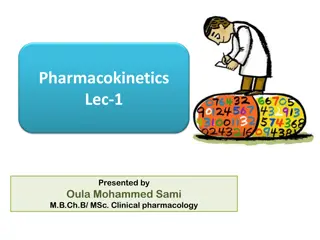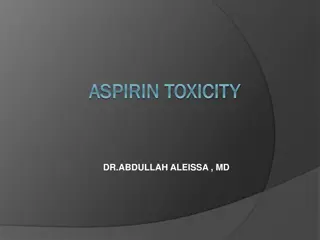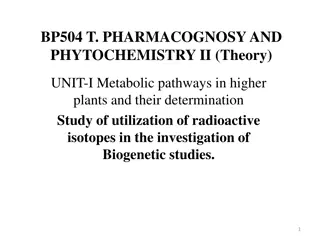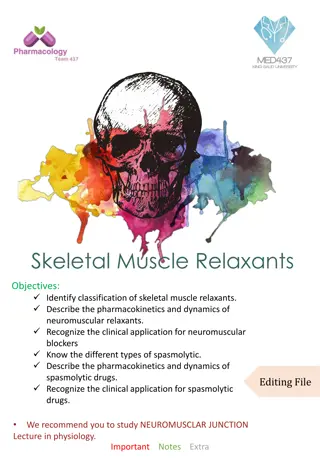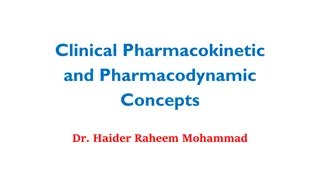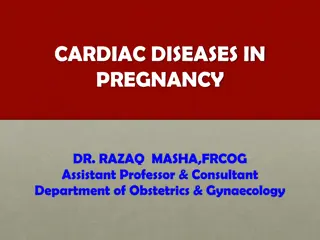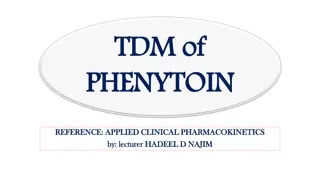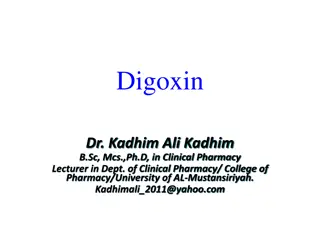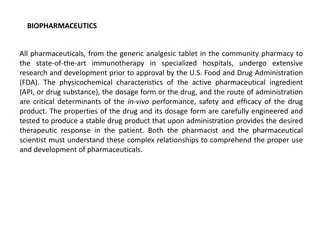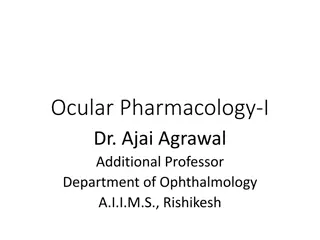Digoxin Pharmacokinetics and Clinical Considerations
This presentation covers the pharmacokinetic parameters, dosing guidelines, therapeutic and toxic concentrations, and factors affecting digoxin clearance and distribution. It explores how digoxin clearance is linked to creatinine clearance, usual dosing regimens for adult patients, and disease states impacting its pharmacokinetics. Monitoring serum levels is crucial to maintain therapeutic efficacy and avoid toxicity.
Download Presentation

Please find below an Image/Link to download the presentation.
The content on the website is provided AS IS for your information and personal use only. It may not be sold, licensed, or shared on other websites without obtaining consent from the author.If you encounter any issues during the download, it is possible that the publisher has removed the file from their server.
You are allowed to download the files provided on this website for personal or commercial use, subject to the condition that they are used lawfully. All files are the property of their respective owners.
The content on the website is provided AS IS for your information and personal use only. It may not be sold, licensed, or shared on other websites without obtaining consent from the author.
E N D
Presentation Transcript
DIGOXIN REFERENCE: APPLIED CLINICAL PHARMACOKINETICS Slideshow by: lecturer HADEEL DELMAN
Digoxin follow 2 compartment model Distribution phase Distribution phase ( (8 8 12 12 hours) hours) Elimination phase Elimination phase IV digoxin Oraldigoxin t t1 1/ /2 2= =36 36h h
Therapeutic and Toxic Concentrations Therapeutic and Toxic Concentrations Inotropic Effects Inotropic Effects of digoxin are generally achieved at steady-state serum concentrations of 0.5 0.5 - - 1 1ng/mL ng/mL.. Chronotropic Chronotropic Effects Effects usually require higher digoxin steady-state serum concentrations of 0.8 0.8 1.5 1.5 ng/mL ng/mL.. Adverse drug reactions Adverse drug reactions increase at steady-state digoxin serum concentration above 2 2 ng/mL ng/mL Digoxin toxicity Digoxin toxicity increase at serum concentration of 2.5 2.5 ng/mL ng/mL or above
Basic Clinical Pharmacokinetic Parameters Basic Clinical Pharmacokinetic Parameters Digoxin elimination from the body occurs by two routes: 1. 1. ~ ~75 75% % via kidney kidney (by glomerular filtration and active tubular secretion) 2. 2. ~ ~25 25% via % via hepatic hepatic metabolism or biliary excretion Plasma protein binding is ~ ~25 25% % for digoxin. Average bioavailability constants (F) for the: tablet= elixir= capsule = tablet=0.7 0.7, , elixir=0.8 0.8, , capsule =0.9 0.9..
Digoxin clearance is proportional to creatinine clearance for patients with or without Digoxin clearance is proportional to creatinine clearance for patients with or without moderate moderate- -severe heart failure. severe heart failure. without moderate without moderate- - severe heart failure severe heart failure with moderate with moderate- - severe heart failure severe heart failure
Usual Digoxin Doses for Adult Patients: Usual Digoxin Doses for Adult Patients: 250 250 g/day function (creatinine clearance 80 mL/min). g/day (range: 125 500 g/d) in patients with good renal good renal 125 125 g every (creatinine clearnace 15 mL/min). g every 2 2 3 3 days days in patients with renal dysfunction renal dysfunction
Disease States and Conditions Disease States and Conditions that alter that alter Digoxin Pharmacokinetics Digoxin Pharmacokinetics
t1/2=0.693V Cl
t1/2=0.693V Cl
Half Half- -life in pediatrics life in pediatrics Digoxin clearance is lower hepatic function are not completely developed. Premature infants Premature infants------- Neonates Neonates---------- ---------- t t1 1/ /2 2 = = 45 45 hours 6 6 months months - - 8 8 years old, years old, --------- 12 12 years old years old -------- -------- t t1 1/ /2 2 = = 36 36 hours lower in neonates and premature infants because renal and ------- t t1 1/ /2 2 = = 60 60 hours hours --------- t t1 1/ /2 2 = = 18 18 hours. hours hours t1/2=0.693V Cl hours. Volume of distribution is larger found with many other drugs. larger in infants and children compared to adults as is
Initial Dosage Determination Methods Initial Dosage Determination Methods 1 1- -The pharmacokinetic dosing method The pharmacokinetic dosing method 2 2- - Jelliffe Jelliffe method method
The pharmacokinetic dosing method The most flexible technique. It allows individualized target serum concentrations for a patient, Each pharmacokinetic parameter can be customized to reflect specific disease states and conditions present in the patient.
Calculations steps: Calculations steps: 1- Estimate digoxin clearance 20 with HF Cl (ml/ min)= 1.303 [CrCl (ml/min)] + ClNR 40 Cl is the digoxin clearance in mL/min, Cl is the digoxin clearance in mL/min, CrCl is creatinine clearance in mL/min, and CrCl is creatinine clearance in mL/min, and Cl ClNR is digoxin non- -renal clearance. renal clearance. without HF NR is digoxin non Note: Note: Cl must be converted from (ml/min) to (L/d) by multiplying the result by (60*24)/1000 or 1.44
2- Estimate digoxin volume of distribution If obese use IBW V= 7 L/kg In renal dysfunction (creatinine clearance 30 mL/min) USE:
3-Steady-State Concentration Selection For heart failure . Css = 0.5 0.5 1 1 ng/mL Target digoxin concentration equal to Target digoxin concentration equal to 0.8 ng/mL 0.8 ng/mL ng/mL Note Note: : For atrial fibrillation Css = 0.8 0.8 1.5 Target digoxin concentration of Target digoxin concentration of 1.2 ng/mL = ng/mL = g/L g/L 1.5 ng/mL ng/mL 1.2 ng/mL ng/mL
4-Selection of Appropriate Model and Equations Css Cl Cl ) / F D = ( D = (Css Css Css = [F (D/ = [F (D/ )] / Cl )] / Cl = = 1 1 day LD = ( LD = (Css Css V) / F V) / F ) / F day D is the digoxin dose in D is the digoxin dose in g, g, is the dosage interval in days, and is the dosage interval in days, and Cl is digoxin clearance in L/d. Cl is digoxin clearance in L/d. F is the bioavailability fraction for the oral dosage form (F = F is the bioavailability fraction for the oral dosage form (F = 1 1 for intravenous digoxin) for intravenous digoxin)
Example Example 1 1 MJ is a 50-year-old, 70-kg (5 ft 10 in) male with atrial fibrillation for less than 24 hours. His current serum creatinine is 0.9 mg/dL, and it has been stable over the last 5 days since admission. Compute an intravenous intravenous digoxin ventricular rate. digoxin dose for this patient to control 1. Estimate creatinine clearance. This patient has a stable serum creatinine and is not obese. The Cockcroft-Gault equation can be used to estimate creatinine clearance: CrClest = [( CrClest = [(140 140 age)BW] / ( age)BW] / (72 72 SCr SCr) ) = [( = [(140 140 50 50 y) y)70 70 kg] / ( kg] / (72 72 0.9 0.9 mg/ CrClest = CrClest = 97 97 mL/min mL/min mg/dL dL) )
2. Estimate clearance. Cl = 1.303 (CrCl) + ClNR = 1.303 (97 mL/min) + 40 mL/min = 167 mL/min the patient does not have moderate to severe heart failure 3. Css for atrial fibrillation= 1.2 ng/mL To covert unit of Cl from ml/min to L/day F=1 for IV route D/ = (Css Cl) / F = (1.2 g/L 167 mL/min 1440 min/d) / (1 1000 mL/L) / 1 = 288 g/d, round to 250 g/d
4. Use loading dose equation to compute digoxin loading dose V = 7 L/kg 70 kg = 490 L LD = (Css V) / F = (1.2 g/L 490 L) / 1 = 588 g rounded to 500 g Note When digoxin loading doses are administered, they are usually given in divided doses separated by 4 6 hours (50% of dose at first, followed by two additional doses of 25%). In this case, an initial intravenous dose of 250 g would be given initially, followed by two additional intravenous doses of 125 g each. One of the loading doses could be withheld if pulse rate was less than 50 60 beats per minute or other undesirable digoxin adverse effects were noted.
Jelliffe method This method depend on the amount of digoxin in the body that produces the desired effect, which is known at the total body stores (TBS) of digoxin. In normal renal function In normal renal function, - Digoxin TBS = 8 12 g/kg required to cause inotropic effects, - Digoxin TBS = 13 15 g/kg needed to cause chronotropic effects. Use Use IBW in IBW in obese obese patients patients In renal dysfunction In renal dysfunction, - Digoxin TBS = 6 10 g/kg
The percent of drug that is lost on a daily basis (%lost/d) is related to renal function according to the following equation: %lost/d = %lost/d = 14 14% + % + 0.20 0.20(CrCl) (CrCl) CrCl is creatinine clearance in mL/min the percent of digoxin eliminated per day by non- renal routes
The maintenance dose and loading dose The maintenance dose and loading dose The maintenance dose: The maintenance dose: D ( D ( g/d) = [TBS Substitute with [ [14 14% + D = {TBS D = {TBS [ [14 14% + The loading dose: The loading dose: LD = TBS/ F LD = TBS/ F g/d) = [TBS (%lost/d)] / F (%lost/d)] / F % + 0.20 0.20(CrCl)] (CrCl)] 0.20(CrCl)]} / (F (CrCl)]} / (F 100 % + 0.20 100) ) A conversion factor to convert the percentage to a fraction
Example Example 1 1 MJ is a 50-year-old, 70-kg (5 ft 10 in) male with atrial fibrillation for less than 24 hours. His current serum creatinine is 0.9 mg/dL, and it has been stable over the last 5 days since admission. Compute an intravenous digoxin dose for this patient to control ventricular ventricular rate rate. 1. Estimate creatinine clearance Estimate creatinine clearance . CrClest = 97 mL/min 2 2. . Estimate total body store (TBS) Estimate total body store (TBS) The patient has good renal function and is non-obese. Digoxin total body stores of 13 15 g/kg are effective in the treatment of atrial fibrillation. A digoxin dose of 14 g/kg is chosen for this patient: TBS = TBS = 14 14 g/kg g/kg 70 70 kg = kg = 980 980 g g
3 3. . Calculate maintenance dose (D). Calculate maintenance dose (D). D = {TBS [14% + 0.20(CrCl)]} / (F 100) = {980 g [14% + 0.20(97 mL/min)]} / (1 100) = 328 g/d, round to 375 g/d 4 4. . Calculate loading dose Calculate loading dose LD = TBS/ F = 980 g / 1 = 980 g, round to 1000 g
USE OF DIGOXIN SERUM USE OF DIGOXIN SERUM CONCENTRATIONS CONCENTRATIONS TO TO ALTER DOSAGES ALTER DOSAGES
1 1- -Linear Pharmacokinetics Method Linear Pharmacokinetics Method - - The advantages of this method are that it is quick and simple. The advantages of this method are that it is quick and simple. - - The disadvantages are The disadvantages are steady steady- -state concentrations state concentrations are required. D Dnew new = ( = (C Css,new ss,new/ /C Css,old are required. ss,old) )D Dold old
Example Example 1 1 MJ is a 50-year-old, 70-kg (5 ft 10 in) male with moderate His current serum creatinine is 0.9 mg/dL, and it has been stable over the last 6 months. A digoxin dose of 250 g/d using oral oral tablets tablets was prescribed and expected to achieve steady-state concentrations equal to 0.8 ng/mL. After a week of treatment, a steady-state digoxin concentration was measured and equalled 0.6 ng/mL. Calculate a new digoxin dose that would provide a steady-state concentration of 0.9 ng/mL. moderate heart heart failure failure. 1 1. Check if digoxin conc. reach to steady state . Check if digoxin conc. reach to steady state.. .. (CrCl+Vd+t 2 2. D . Dnew new = ( = (C Css,new ss,new/ /C Css,old ss,old) )D Dold old = ( = (0.9 0.9 ng/mL / ng/mL / 0.6 0.6 ng/mL) ng/mL) 250 = = 375 375 g/d g/d (CrCl+Vd+t1 1/ /2 2) ) .. steady state 250 g/d g/d
2 2- -Pharmacokinetic Parameter Method Pharmacokinetic Parameter Method This method calculates the patient-specific drug clearance by using the obtained Css: Cl = [F (D/ Cl = [F (D/ )] / )] / Css Css where Cl is digoxin clearance in L/d Then use this actual clearance to calculate new dose: Css Cl Cl ) / F D = ( D = (Css ) / F
Example Example 1 1 MJ is a 50-year-old, 70-kg (5 ft 10 in) male with moderate heart failure. His current serum creatinine is 0.9 mg/dL, and it has been stable over the last 6 months. A digoxin dose of 250 250 g/d g/d using oral oral tablets tablets was prescribed and expected to achieve steady-state concentrations equal to 0.8 ng/mL. After a week of treatment, a steady-state digoxin concentration was measured and equalled 0.6 ng/mL. Calculate a new digoxin dose that would provide a steady-state concentration of 0.9 ng/mL. 1. Estimate creatinine clearance. 2. Compute drug clearance. Cl = [F(D/ Cl = [F(D/ )] )]/ /Css Css = [ = [0.7 0.7( (250 250 g/d)] / g/d)] / 0.6 0.6 g/L = g/L = 292 292 L/d L/d 3. Compute new dose to achieve desired serum concentration. D/ D/ = ( = (Css Css Cl) / F = ( Cl) / F = (0.9 0.9 g/L g/L 292 375 g/d 292 L/d) / L/d) / 0.7 0.7 = = 375 g/d
Use of Digoxin Booster Doses to Immediately Increase Serum Concentrations Use of Digoxin Booster Doses to Immediately Increase Serum Concentrations If a patient has a subtherapeutic digoxin serum concentration in an acute situation, it may be desirable to increase the digoxin concentration as quickly as possible. A modified loading dose equation is used to accomplish computation of the booster dose (BD) which takes into account the current digoxin concentration present in the patient: BD = [( BD = [(C Cdesired desired C Cactual actual) V] /F ) V] /F
Example Example 1 1 BN is a 52-year-old, 85-kg (6 ft 2 in) male with atrial fibrillation who is receiving therapy with intravenous digoxin. He has normal liver and renal function. After receiving an initial loading dose of digoxin (1000 g) and a maintenance dose of 250 g/d of digoxin for 5 days, his digoxin concentration is measured at 0.6 ng/mL immediately after pulse rate increased to 200 beats/min. Compute a booster a digoxin concentration equal to 1.5 ng/mL. booster dose dose of of digoxin digoxin to achieve 1 1. . Estimate volume of distribution according to disease states and conditions present in the patient V = V = 7 7 L/kg L/kg 85 85 kg = kg = 595 595 L L 2 2. . Compute booster dose. BD = [( BD = [(Cdesired Cdesired Cactual Cactual) V]/F ) V]/F = [(1.5 g/L 0.6 g/L) 595 L] / 1 = 536 g, rounded to 500 g of digoxin.
Conversion of Patient Doses Between Dosage Forms When patients are switched between digoxin dosage forms, differences in bioavailability bioavailability should be accounted, using the following equation: D DIV IV is the equivalent digoxin intravenous dose in g, D DPO F F is the bioavailability fraction appropriate for the oral dosage form (F = 0.7 for tablets, 0.8 for elixir, 0.9 for capsules). Conversion of Patient Doses Between Dosage Forms PO F F D DIV IV = D = DPO PO is the equivalent digoxin oral dose, and
Example Example 1 1 YT is a 67-year-old, 60-kg (5 ft 5 in) male with atrial fibrillation receiving 200 g of intravenous digoxin daily which produces a steady-state digoxin concentration of 1.3 ng/mL. Compute an oral tablet dose that will maintain steady-state digoxin concentrations at approximately the same level. 1 1. . Convert current digoxin dose to the equivalent amount for the new dosage form/route. D DPO = DIV IV/ F = / F = 200 200 g / g / 0.7 0.7 = = 286 286 g digoxin tablets, round to g digoxin tablets, round to 250 250 g g PO = D 2 2. . Estimate change in digoxin steady-state concentration due to rounding of dose. Cssnew Cssnew = = Cssold Cssold( (Drounded Drounded/ /Dcomputed Dcomputed) ) = = 1 1..3 3 ng/mL( 250 g g / / 286 286 g) g) = = 1 1..1 1 ng/mL ng/mL(250 ng/mL
Use of Digoxin Immune Fab in Digoxin Overdoses Use of Digoxin Immune Fab in Digoxin Overdoses Digoxin immune Fab (Digibind) are digoxin antibody molecule segments that bind and neutralize digoxin which can be used in digoxin overdose situations Improvements in digoxin adverse effects can be seen within 30 minutes of digoxin immune Fab administration.
Use of Digoxin Immune Fab in Digoxin Overdoses Use of Digoxin Immune Fab in Digoxin Overdoses 1. If a digoxin serum concentration or an estimate of the number of tablets ingested are not not available, 20 vials of Digibind are usually adequate to treat most life-threatening acute overdoses in children and adults. (In less emergent situations, 10 vials may be initially given, patient response monitored, and an additional 10 vials administered, if necessary). 2. To treat chronic digoxin overdoses, 6 vials are usually needed for adults and older children while 1 vial is usually adequate for children under the weight of 20 kg
3 3. Chronic Overdose or Acute Overdose . Chronic Overdose or Acute Overdose 8 8 12 12 Hours After Ingestion After Ingestion Hours In these cases, a postabsorption, postdistribution digoxin concentration can be used to estimate the necessary dose of Digibind for a patient using the following formula: Digibind dose (in vials) = [digoxin concentration (ng/mL)][body weight (kg)] / Digibind dose (in vials) = [digoxin concentration (ng/mL)][body weight (kg)] / 100 100
Example Example HY is a 72-year-old, 80-kg (5 ft 7 in ) male who has accidently been taking twice his prescribed dose of digoxin tablets. The admitting digoxin serum concentration is 4.1 ng/mL. Compute an appropriate dose of Digibind for this patient. Digibind dose (in vials) = [digoxin concentration (ng/mL)][body weight (kg)]/ Digibind dose (in vials) = [digoxin concentration (ng/mL)][body weight (kg)]/100 = ( = (4.1 4.1 ng/mL ng/mL 80 80 kg)/ = = 3.3 3.3 vials, rounded up to vials, rounded up to 4 4 vials 100 kg)/100 100 vials
4 4- - Acute Overdose Where Number of Tablets is Known Acute Overdose Where Number of Tablets is Known or Can Be Estimated or Can Be Estimated For this situation, digoxin total body stores are estimated using the number of tablets ingested corrected for dosage form bioavailability: TBS = F (# dosage units) (dosage form strength (mg)) TBS = F (# dosage units) (dosage form strength (mg)) #dosage units: #dosage units: is the number of tablets or capsules Each vial of Digibind will inactivate approximately 0.5 dose of Digibind (in vials) can be calculated using the following equation: Digibind dose = TBS/ ( Digibind dose = TBS/ (0.5 0.5 mg of digoxin mg of digoxin, so the 0.5 mg/vial) mg/vial)
Example Example DL is a 22-year-old, 85-kg (5 ft 9 in) male who took approximately 50 digoxin tablets of 0.25-mg strength about 4 hours ago. Compute an appropriate dose of Digibind for this patient. TBS = F(# dosage units)(dosage form strength) TBS = F(# dosage units)(dosage form strength) = = 0.8 0.8 ( (50 50 tablets tablets 0.25 = = 10 10 mg mg Digibind dose = TBS/ ( Digibind dose = TBS/ (0.5 = = 10 10 mg / ( mg / (0.5 = = 20 20 vials vials 0.25 mg/tablet) mg/tablet) 0.5 mg/vial) mg/vial) 0.5 mg/vial) mg/vial)



